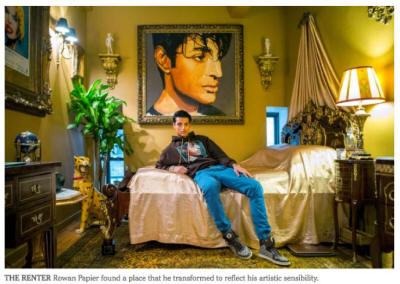
An Apartment In His Own Image, Extended
Growing up in the English Midlands, Rowan Papier always considered himself a “creative soul,” he said.
As a teenager, he showed photographs he had taken to some professional connections he made via a sister who was a child model. That led, several years ago, to an internship in the studio of Bruce Weber, later followed by one with David LaChapelle.
When he arrived in New York in 2010, Mr. Papier — whose father is American — stayed with relatives in Bayside, Queens, for a few weeks. Later, he moved among Bushwick, Williamsburg and Harlem, rooming with friends and staying in sublets.
“I was roughing it,” he said. “I was living out of two suitcases.” Back then, the novelty of a new apartment every few months was exciting. Now, at 22, “I cannot imagine trying to live out of a few suitcases,” he said.
Last year, Mr. Papier found himself in the 11th apartment he had inhabited in New York, a Chinatown two-bedroom in a postwar midrise condominium. He paid a bit more than half of the $2,300 rent.
It was close to the Manhattan Bridge in Chinatown, “probably my least favorite neighborhood I’ve lived in,” he said. The streets were crowded and dirty. “I had no feeling of familiarity in Chinatown. I was craving a neighborhood with cute coffee shops, where you have brunch with friends.”
Mr. Papier had been living frugally, working as a photographer and saving to be able to rent a place that felt like home. In the spring, he began hunting in Greenwich Village and on the Lower East Side, often finding himself faced with “a tossup, like space vs. recently renovated vs. neighborhood,” he said.
“I was aware I was going to have to downgrade in size” to end up in a coveted neighborhood, with a place filled with “charm and a feeling of authentic New York,” he said.
Mr. Papier soon found that a price in the $2,000s for a one-bedroom was unrealistic. He figured he could find a nicer two-bedroom in the mid-to-high $3,000s. If need be, he could rent the second room to a friend.
In a nondescript mid-war condominium in TriBeCa, a two-bedroom was available for $3,900 a month. But the ceilings were low and the building plain.
The location was less than ideal, too. Mr. Papier hesitated about being just two blocks from busy Canal Street. “Canal Street is so crazy it is like Times Square or Broadway or something, it is so intense.”
On the Lower East Side, a renovated two-bedroom in a building with a roof deck and a gym was almost $4,000. “It was pristine,” Mr. Papier said, but small in every way. “The staircases were tiny, the closets were tiny, you open the door to the bedroom and immediately walk into the bed.”
And it was on the top floor of a six-story walk-up. “That is a lot of money to have something that is an inconvenience to you,” said Mr. Papier, who travels often, lugging suitcases. “If it is a dream apartment, you can suck it up,” but this was not.
In NoLIta, a two-bedroom was advertised at around $4,100. Mr. Papier loved the location, “a stone’s throw from Whole Foods.” But this one wasn’t a real two-bedroom; a temporary wall had been removed.The mismatch of housing stock and neighborhood was sinking in. Mr. Papier didn’t want a small walk-up building, but his targeted neighborhoods were filled with them. “I am envisioning a TriBeCa loft with character in Greenwich Village, which is kind of impossible to find.”
But the character he sought, if not the loft, appeared when an agent took him to a co-op building on Bleecker Street in Greenwich Village, originally built as a hotel, with a soaring interior atrium. The apartment had two bedrooms covering 850 square feet and the high ceilings Mr. Papier craved. The rent was $3,700.
He loved it instantly. “It matched my aesthetic,” he said. “I felt this was a rare find.” After a lengthy application process, Mr. Papier paid a fee of 12 percent of a year’s rent — more than $5,000 — and moved in over the summer.
The neighborhood is full of cute coffee shops and places for brunch. On busy Bleecker Street, “when you step out on a Friday night, it is really crazy outside,” he said. Inside, however, he faces an air shaft. “It’s so quiet it’s eerie. I have no idea whether I have neighbors or not.”
His bedroom, with two skinny windows, receives little light. That’s fine with Mr. Papier, who sometimes does photo retouching there. He worked for hours on a full-page photo just published in Vogue Australia.
He decorated his bedroom lavishly, prominently hanging an image of himself on one wall. Some of the furniture was custom made; some is antique. “I felt I had never been content with my surroundings,” he said. Now, he absolutely is.
“Home decorating turned into one of my projects,” he said. “It’s a luxurious pop-art environment that reflects my taste and is a true representation of me.”
